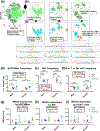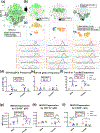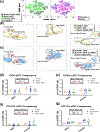Peripherally-sourced myeloid antigen presenting cells increase with advanced aging
- PMID: 32861719
- PMCID: PMC8169202
- DOI: 10.1016/j.bbi.2020.08.023
Peripherally-sourced myeloid antigen presenting cells increase with advanced aging
Abstract
Aging is associated with dysfunction of the gut microbiota-immune-brain axis, a major regulatory axis in both brain health and in central nervous system (CNS) diseases. Antigen presenting cells (APCs) play a major role in sensing changes in the gut microbiota and regulation of innate and adaptive immune responses. APCs have also been implicated in various chronic inflammatory conditions, including age-related neurodegenerative diseases. The increase in chronic low-level inflammation seen with aging has also been linked to behavioral decline. Despite their acknowledged importance along the gut microbiota-immune-brain axis, there is limited evidence on how APCs change with aging. In this study, we examined age-related changes in myeloid APCs in the gut, spleen, and brain as well as changes in the gut microbiota and behavioral phenotype in mice ranging in age from 2 months up to 32 months of both sexes. Our data show that the number of peripherally-sourced myeloid APCs significantly increases with advanced aging in the brain. In addition, our data showed that age-related changes in APCs are subset-specific in the gut and sexually dimorphic in the spleen. Our work highlights the importance of studying myeloid APCs in an age-, tissue-, and sex-specific manner.
Keywords: Aging; Behavior; Dendritic cells; Gut microbiota-immune-brain axis; MHC-II; Myeloid cells; Sex differences.
Copyright © 2020 The Authors. Published by Elsevier Inc. All rights reserved.
Conflict of interest statement
Declaration of Competing Interest The authors declare that they have no known competing financial interests or personal relationships that could have appeared to influence the work reported in this paper.
Figures





Similar articles
-
The microbiota-immune axis as a central mediator of gut-brain communication.Neurobiol Dis. 2020 Mar;136:104714. doi: 10.1016/j.nbd.2019.104714. Epub 2019 Dec 14. Neurobiol Dis. 2020. PMID: 31846737 Review.
-
Effects of chronic noise exposure on the microbiome-gut-brain axis in senescence-accelerated prone mice: implications for Alzheimer's disease.J Neuroinflammation. 2018 Jun 22;15(1):190. doi: 10.1186/s12974-018-1223-4. J Neuroinflammation. 2018. PMID: 29933742 Free PMC article.
-
Gut-brain Axis: Role of Lipids in the Regulation of Inflammation, Pain and CNS Diseases.Curr Med Chem. 2018;25(32):3930-3952. doi: 10.2174/0929867324666170216113756. Curr Med Chem. 2018. PMID: 28215162 Review.
-
Impact of microbiota on central nervous system and neurological diseases: the gut-brain axis.J Neuroinflammation. 2019 Mar 1;16(1):53. doi: 10.1186/s12974-019-1434-3. J Neuroinflammation. 2019. PMID: 30823925 Free PMC article. Review.
-
Regional and functional heterogeneity of antigen presenting cells in the mouse brain and meninges.Glia. 2019 May;67(5):935-949. doi: 10.1002/glia.23581. Epub 2018 Dec 26. Glia. 2019. PMID: 30585356
Cited by
-
The role of Western diets and obesity in peripheral immune cell recruitment and inflammation in the central nervous system.Brain Behav Immun Health. 2021 Jul 15;16:100298. doi: 10.1016/j.bbih.2021.100298. eCollection 2021 Oct. Brain Behav Immun Health. 2021. PMID: 34589790 Free PMC article.
-
CD11bhigh B Cells Increase after Stroke and Regulate Microglia.J Immunol. 2022 Jul 15;209(2):288-300. doi: 10.4049/jimmunol.2100884. Epub 2022 Jun 22. J Immunol. 2022. PMID: 35732342 Free PMC article.
-
Age-related immune alterations and cerebrovascular inflammation.Mol Psychiatry. 2022 Feb;27(2):803-818. doi: 10.1038/s41380-021-01361-1. Epub 2021 Oct 28. Mol Psychiatry. 2022. PMID: 34711943 Free PMC article. Review.
-
Neutrophils and Neutrophil Extracellular Traps Cause Vascular Occlusion and Delayed Cerebral Ischemia After Subarachnoid Hemorrhage in Mice.Arterioscler Thromb Vasc Biol. 2024 Mar;44(3):635-652. doi: 10.1161/ATVBAHA.123.320224. Epub 2024 Feb 1. Arterioscler Thromb Vasc Biol. 2024. PMID: 38299355 Free PMC article.
-
Aging Microbiota-Gut-Brain Axis in Stroke Risk and Outcome.Circ Res. 2022 Apr 15;130(8):1112-1144. doi: 10.1161/CIRCRESAHA.122.319983. Epub 2022 Apr 14. Circ Res. 2022. PMID: 35420913 Free PMC article. Review.
References
-
- Adhikaree J, Franks HA, Televantos C, Vaghela P, Kaur AP, Walker D, Schmitz M, Jackson AM, Patel PM, 2019. Impaired circulating myeloid CD1c+ dendritic cell function in human glioblastoma is restored by p38 inhibition - implications for the next generation of DC vaccines. Oncoimmunology 8, 1593803. 10.1080/2162402X.2019.1593803 - DOI - PMC - PubMed
-
- Anandasabapathy N, Victora GD, Meredith M, Feder R, Dong B, Kluger C, Yao K, Dustin ML, Nussenzweig MC, Steinman RM, Liu K, 2011. Flt3L controls the development of radiosensitive dendritic cells in the meninges and choroid plexus of the steady-state mouse brain. J. Exp. Med. 208, 1695–705. 10.1084/jem.20102657 - DOI - PMC - PubMed
-
- Baruch K, Deczkowska A, David E, Castellano JM, Miller O, Kertser A, Berkutzki T, Barnett-Itzhaki Z, Bezalel D, Wyss-Coray T, Amit I, Schwartz M, 2014. Aging. Aging-induced type I interferon response at the choroid plexus negatively affects brain function. Science 346, 89–93. 10.1126/science.1252945 - DOI - PMC - PubMed
Publication types
MeSH terms
Grants and funding
LinkOut - more resources
Full Text Sources
Research Materials
Miscellaneous

